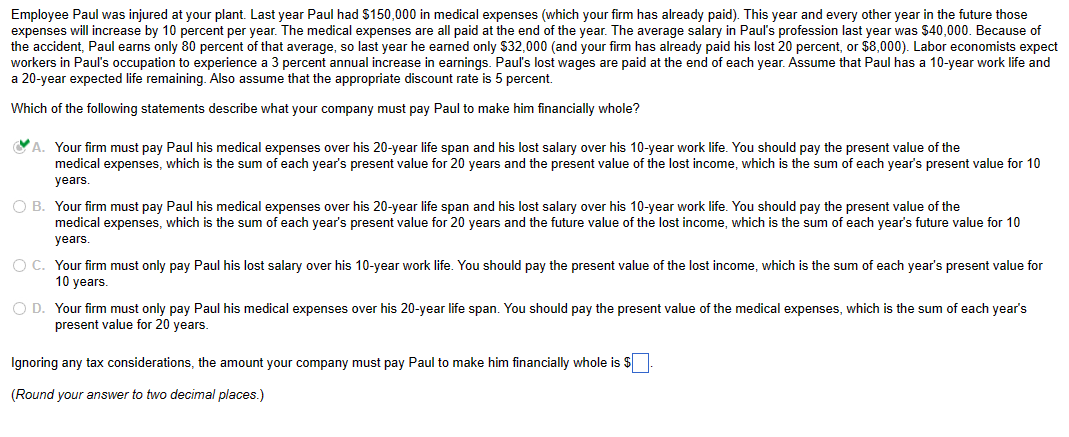Answered step by step
Verified Expert Solution
Question
1 Approved Answer
Employee Paul was injured at your plant. Last year Paul had ( $ 150,000 ) in medical expenses (which your firm has already paid). This
 Employee Paul was injured at your plant. Last year Paul had \\( \\$ 150,000 \\) in medical expenses (which your firm has already paid). This year and every other year in the future those expenses will increase by 10 percent per year. The medical expenses are all paid at the end of the year. The average salary in Paul's profession last year was \\( \\$ 40,000 \\). Because of the accident, Paul earns only 80 percent of that average, so last year he earned only \\( \\$ 32,000 \\) (and your firm has already paid his lost 20 percent, or \\( \\$ 8,000 \\) ). Labor economists expect workers in Paul's occupation to experience a 3 percent annual increase in earnings. Paul's lost wages are paid at the end of each year. Assume that Paul has a 10-year work life and a 20 -year expected life remaining. Also assume that the appropriate discount rate is 5 percent. Which of the following statements describe what your company must pay Paul to make him financially whole? A. Your firm must pay Paul his medical expenses over his 20-year life span and his lost salary over his 10-year work life. You should pay the present value of the medical expenses, which is the sum of each year's present value for 20 years and the present value of the lost income, which is the sum of each year's present value for 10 years. B. Your firm must pay Paul his medical expenses over his 20-year life span and his lost salary over his 10-year work life. You should pay the present value of the medical expenses, which is the sum of each year's present value for 20 years and the future value of the lost income, which is the sum of each year's future value for 10 years. C. Your firm must only pay Paul his lost salary over his 10-year work life. You should pay the present value of the lost income, which is the sum of each year's present value for 10 years. D. Your firm must only pay Paul his medical expenses over his 20 -year life span. You should pay the present value of the medical expenses, which is the sum of each year's present value for 20 years. Ignoring any tax considerations, the amount your company must pay Paul to make him financially whole is \\( \\$ \\) (Round your answer to two decimal places.)
Employee Paul was injured at your plant. Last year Paul had \\( \\$ 150,000 \\) in medical expenses (which your firm has already paid). This year and every other year in the future those expenses will increase by 10 percent per year. The medical expenses are all paid at the end of the year. The average salary in Paul's profession last year was \\( \\$ 40,000 \\). Because of the accident, Paul earns only 80 percent of that average, so last year he earned only \\( \\$ 32,000 \\) (and your firm has already paid his lost 20 percent, or \\( \\$ 8,000 \\) ). Labor economists expect workers in Paul's occupation to experience a 3 percent annual increase in earnings. Paul's lost wages are paid at the end of each year. Assume that Paul has a 10-year work life and a 20 -year expected life remaining. Also assume that the appropriate discount rate is 5 percent. Which of the following statements describe what your company must pay Paul to make him financially whole? A. Your firm must pay Paul his medical expenses over his 20-year life span and his lost salary over his 10-year work life. You should pay the present value of the medical expenses, which is the sum of each year's present value for 20 years and the present value of the lost income, which is the sum of each year's present value for 10 years. B. Your firm must pay Paul his medical expenses over his 20-year life span and his lost salary over his 10-year work life. You should pay the present value of the medical expenses, which is the sum of each year's present value for 20 years and the future value of the lost income, which is the sum of each year's future value for 10 years. C. Your firm must only pay Paul his lost salary over his 10-year work life. You should pay the present value of the lost income, which is the sum of each year's present value for 10 years. D. Your firm must only pay Paul his medical expenses over his 20 -year life span. You should pay the present value of the medical expenses, which is the sum of each year's present value for 20 years. Ignoring any tax considerations, the amount your company must pay Paul to make him financially whole is \\( \\$ \\) (Round your answer to two decimal places.) Step by Step Solution
There are 3 Steps involved in it
Step: 1

Get Instant Access to Expert-Tailored Solutions
See step-by-step solutions with expert insights and AI powered tools for academic success
Step: 2

Step: 3

Ace Your Homework with AI
Get the answers you need in no time with our AI-driven, step-by-step assistance
Get Started


